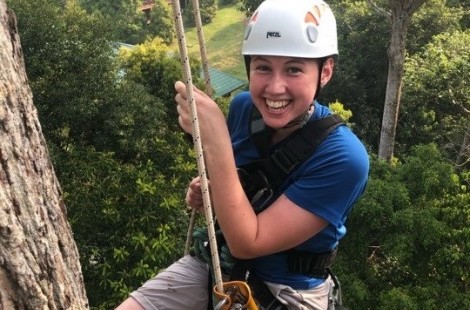
This summer I took part in the Cambridge University part II Zoology field course in Borneo. The field course began in the city of Kota Kinabalu with a visit to the Universiti Malaysia Sabah (UMS). We learnt about the conservation research being carried out at UMS, in particular, studies on riparian buffers at the edges of oil palm plantations and nature tourism. Next, we visited the South East Asia Rainforest Research Partnership (SEARRP) to hear about the impacts of the widespread conversion of Borneo’s land to oil palm plantations. Finally, we visited the Kota Kinabalu Wetlands Reserve to carry out mini projects looking at herbivory, vegetation structure, microclimates, leaf and anthropogenic litter.
On our second day, we visited two islands off the coast of Kota Kinabalu. We were able to compare the impacts of nature tourism on the two islands and further our understanding of tropical marine ecosystems during snorkelling among the corals and by visiting Gaya Islands’ Marine Ecology Research Centre. The following day we travelled to the Maliau Basin Studies Centre in the south of Sabah. On the way we stopped at a large oil palm plantation and were able to discuss sustainability and government regulations with the plantation’s manager.
During our first day at Maliau we went on a forest walk to observe the primary rainforest ecosystem and had a talk by Dr Coomes about the vegetation of tropical forests. We then designed and carried out mini projects, with our group focusing on the differences in abundance and species richness of dragonflies in disturbed and forest areas. In the evening we presented our findings to the rest of class for discussion. The next day was spent planning and designing week long projects.
Our group chose to study how logging and soil type affects forest structure and consequently how carbon storage and herbivory levels are affected. In order to do this, we compared areas of forest with different levels of logging and different soil types. We took measurements of forest structure, including tree diameter, species, canopy cover and understory vegetation. We used these measurements to gain an estimate of the total above ground carbon stocks at each site. In addition, we recorded levels of leaf herbivory on saplings and canopy (using leaf litter samples). On the final day, we analysed the data and presented our findings to the demonstrators and the rest of the class.
In addition to working on the project, we were also able to join other activities at the centre, such as small mammal trapping, early morning bird watching walks and night drives. In the evenings we often attended talks by the demonstrators and staff at Maliau. We also went on a two-day hike to visit the Kerangas forest and learn about its unique ecology and species of pitcher plants.
I am extremely grateful to the Gateway fund as the money I received helped me to cover the costs of the course.
Georgia May Daykin
Sciences